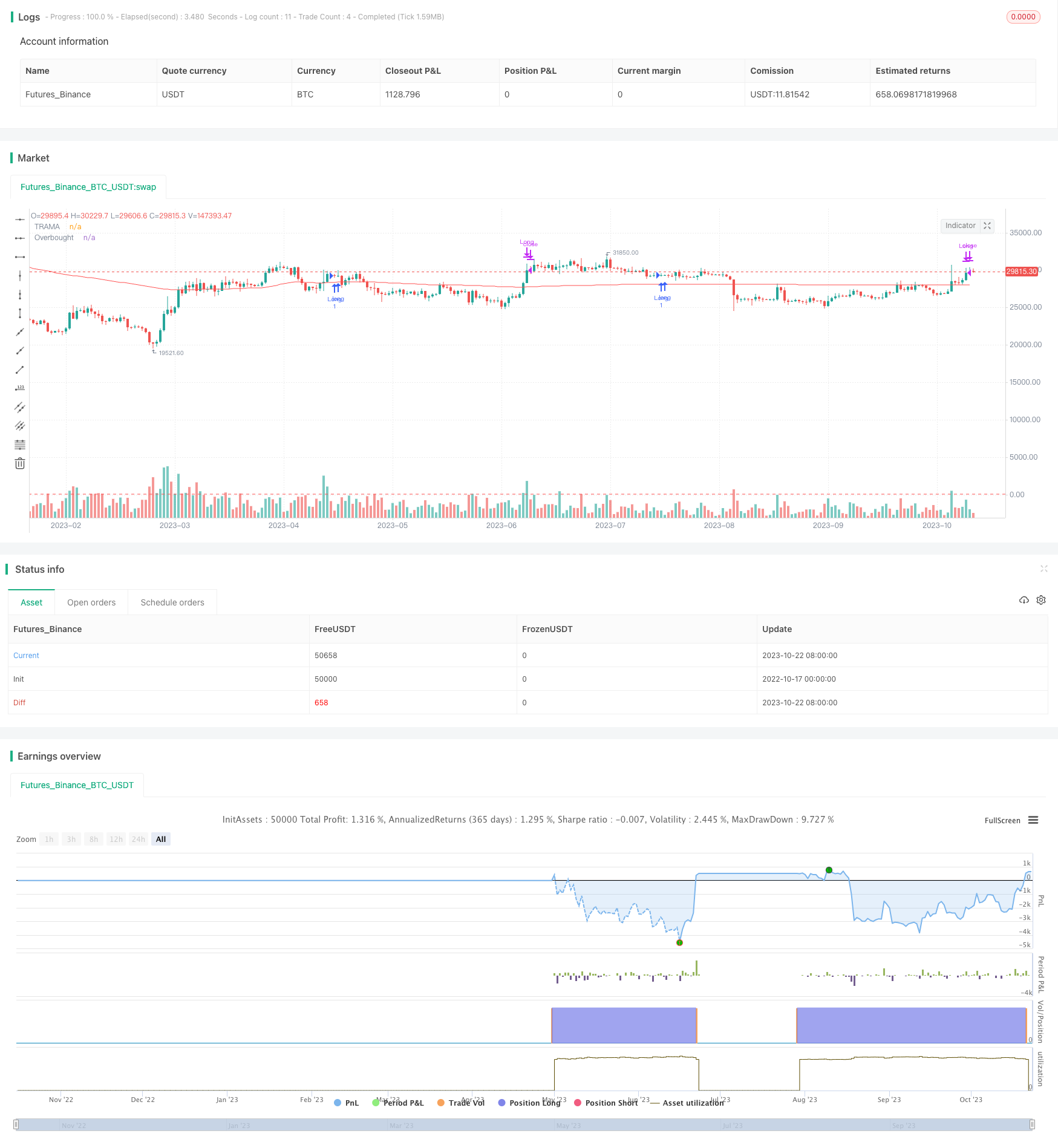
개요
월별 트렌드 브레이크 전략은 파인 스크립트를 기반으로 한 TradingView 지표이다. 이 전략은 자율적인 이동 평균, 트렌드 라인 브레이크 및 RSI 지표의 조합을 사용하여 한 달에 한 번만 다중이 입상할 때를 결정한다. RSI 지표가 초과 구매를 표시하면 평형 상태에서 퇴출한다.
전략 원칙
변수를 정의 lastEntryMonth 기록의 마지막 입문 달. currentMonth는 현재 달을 얻는다.
TRAMA를 이동 평균 변수 length=99에 적응하도록 설정하여 가격을 평형화하고 트렌드 방향을 판단하십시오.
length_trend=14을 설정하고, upper의 최고점을 그리는 트렌드 라인을 설정합니다. 가격이 트렌드 라인을 상단으로 통과하면 돌파구로 판단합니다.
RSI 지표 파라미터를 계산 rsiLength=14, 과매매를 판단한다.
진입 논리: 종전 가격이 TRAMA보다 높고, 종전 가격이 궤도를 돌파할 때, 지난 달에 진입하지 않았다면, 더 많은 진입을 한다.
출전 논리: RSI가 70보다 크면 평점
트라마 곡선을 그리고 RSI의 초상 구매 선을 그리고 전략을 완성한다.
이 전략은 세 가지 주요 기술 지표를 통합하여 트렌드, 모멘텀, 과매매 상황을 판단하고, 한 달에 한 번만 더 낮은 위험을 더 많이 할 기회를 찾습니다. 또한, 가격의 상승 추세를 뚫고 들어오는 것 만을 제한하고, 평형 영역에서 무효 연산을 피합니다.
우위 분석
다양한 지표의 조합, 시장 상태를 종합적으로 판단하고, 의사 결정의 정확성을 향상시킵니다.
월간 시간 프레임이 깨졌을 때만 입점하고, 자주 거래하는 것을 피하십시오.
이동 평균을 사용하여 트렌드 방향을 판단하여 전환을 빠르게 잡을 수 있습니다.
과매매 지표와 함께 시장 고점을 피하고, 위험을 효과적으로 통제한다.
간단한, 직관적인 입출장 조건, 쉽게 파악할 수 있다.
더 나은 전략 최적화를 위해 필요에 따라 매개 변수를 조정할 수 있습니다.
위험 분석
파격 실패로 인한 휘프사우 위험. 출입 후 가격이 다시 추락하여 손실이 발생할 수 있습니다.
트렌드 돌파 시점 선택은 좋지 않으며, 상위 근처의 높은 입구를 선택한다.
지표 파라미터가 잘못 설정되어 지표가 잘못된 신호를 낸다.
브레이크만 Reflect recent market volatility. Consider adaptive stops/position sizing. 최근 시장의 변동성을 반영하기 위한 브레이크만.
Monitor risk/reward. Consider only trading pullbacks or adding other confirmation filters.
Validate indicators on multiple timeframes. Use higher timeframes to identify trend and lower for entry.
Backtest over different market conditions. Optimize parameters to match strategy to market type.
최적화 방향
Volume, MA 거래량 지표의 확인을 추가하여 낮은 양의 가짜 돌파구를 피하십시오.
RSI가 평평한 지위를 초과할 때, 일부 이익의 손실을 고려하고 나머지는 지위를 유지하십시오.
이동 평균 파라미터를 최적화하고, 변화에 적응하고, 트렌드 전환을 더 잘 추적한다.
돌파점 전후 구간을 설정하고, 전환점 고위점으로 직접 진입하는 것을 피한다.
더 많은 필터링 조건을 추가하여 의사 결정의 정확성을 향상시킵니다.
등급 입시, 가격이 새로운 저항선을 돌파하는 것을 계속할 때, 지분을 올릴 수 있다.
요약하다
월간 트렌드 브레이킹 전략은 종합적으로 트렌드, 에너지 및 한계 상태와 같은 여러 가지 요소를 고려합니다. 월간 시간 프레임에서 트렌드 방향을 판단하고 더 낮은 시간 프레임의 브레이킹 실행에 참여합니다. 동시에 RSI 지표를 사용하여 거래 위험을 효과적으로 제어합니다. 이 전략은 매월 한 번 더 우수한 기회를 찾는 간단한 논리를 사용합니다. 트렌드 추적을 고려하고 위험 관리에 중점을 둡니다.
/*backtest
start: 2022-10-17 00:00:00
end: 2023-10-23 00:00:00
period: 1d
basePeriod: 1h
exchanges: [{"eid":"Futures_Binance","currency":"BTC_USDT"}]
*/
//@version=5
strategy('Bannos Strategy', shorttitle='Bannos', overlay=true)
//The provided script is an indicator for TradingView written in Pine Script version 5. The indicator is used to determine entry and exit points for a trading strategy. Here's a detailed breakdown of what the script does:
// Strategy Definition:
// Bannos Strategy is the full name, with a short title Bannos.
// The overlay=true option indicates that the strategy will be overlayed on the price chart.
// Tracking Entry Month:
// A variable lastEntryMonth is set up to track the month of the last entry.
// currentMonth identifies the current month.
// Trend Regularity Adaptive Moving Average (TRAMA):
// It takes an input of length 99 as default.
// It uses adaptive calculations to track trend changes.
// Trendlines with Breaks:
// Identifies local peaks over a given period (in this case, 14) and calculates a slope based on these peaks.
// Relative Strength Index (RSI):
// Uses a length of 14 (default) to calculate the RSI.
// RSI is an oscillation indicator that indicates overbought or oversold conditions.
// Strategy Logic for Long Entry:
// A long position is opened if:
// The close price is above the TRAMA.
// There's a crossover of the close price and the upper trendline.
// The position is taken only once per month.
// Strategy Logic for Long Exit:
// The long position is closed if the RSI exceeds 70, indicating an overbought condition.
// Plotting:
// The TRAMA is plotted in red on the chart.
// A horizontal line is also drawn at 70 to indicate the RSI's overbought zone.
// In summary, this strategy aims to enter a long position when certain trend and crossover conditions are met, and close the position when the market is considered overbought as per the RSI. Additionally, it ensures entries only occur once a month.
//
// Variable pour suivre le mois de la dernière entrée
var float lastEntryMonth = na
currentMonth = month(time)
// Parameters for Trend Regularity Adaptive Moving Average (TRAMA)
length_trama = input(99)
src_trama = close
ama = 0.
hh = math.max(math.sign(ta.change(ta.highest(length_trama))), 0)
ll = math.max(math.sign(ta.change(ta.lowest(length_trama)) * -1), 0)
tc = math.pow(ta.sma(hh or ll ? 1 : 0, length_trama), 2)
ama := nz(ama[1] + tc * (src_trama - ama[1]), src_trama)
// Parameters for Trendlines with Breaks
length_trend = 14
mult = 1.0
ph = ta.pivothigh(length_trend, length_trend)
upper = 0.
slope_ph = 0.
slope_ph := ph ? mult : slope_ph
upper := ph ? ph : upper - slope_ph
// Parameters for RSI
rsiLength = 14
up = ta.rma(math.max(ta.change(close), 0), rsiLength)
down = ta.rma(-math.min(ta.change(close), 0), rsiLength)
rsi = down == 0 ? 100 : up == 0 ? 0 : 100 - (100 / (1 + up / down))
// Strategy Logic for Long Entry
longCondition = close > ama and ta.crossover(close, upper) and (na(lastEntryMonth) or lastEntryMonth != currentMonth)
if (longCondition)
lastEntryMonth := currentMonth
strategy.entry('Long', strategy.long)
// Strategy Logic for Long Exit
exitCondition = rsi > 70
if (exitCondition)
strategy.close('Long')
// Plotting
plot(ama, 'TRAMA', color=color.red)
hline(70, 'Overbought', color=color.red)